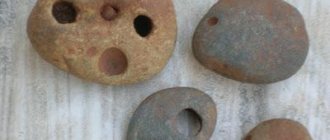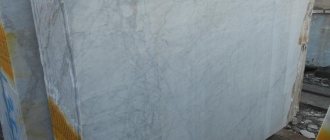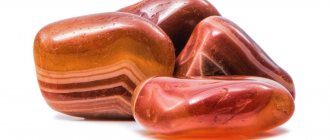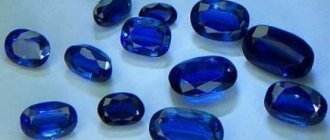Few materials have as many different uses as marble. This stone has a number of useful properties that make it indispensable in industry and art. It is easy to cut and polished with special tools; it has a unique aesthetics. Marble products are popular all over the world, among all segments of the population. This article talks about the origin of marble and its properties, the extraction and use of its varieties in many areas of life.
What is marble
Marble (translated from Greek as “shining”) is a crystalline rock formed as a result of metamorphic transformations of carbonates - limestone and dolomite. Metamorphisms occur under high pressure and high temperature, as a result of which marble has a granular structure and is easy to process. Marble is a valuable and rare material that is used in various fields - construction, art, architecture. Due to its crystalline structure, the stone has patterns formed by the iridescence of various shades depending on its origin.
Marble for exterior decoration
Marble cladding is relevant not only for interior work - the stone is also used for finishing facades, as well as in landscape design. If natural marble is used for facade work, then for this you should choose:
- Stone mosaic;
- Chip stone;
- Large slabs;
- Finishing boards.
The surface of the stone for external finishing work can be matte or untreated - with natural roughness and chips. Polishing reveals the stone's pattern more fully, but makes it more demanding in terms of operating conditions.
In landscape design, marble is as relevant and in demand as many centuries ago: marble chips are used to fill flower beds and alpine slides, and solid stone is used to create garden sculptures, gazebos, flowerpots and other small architectural forms.
Marble is a noble natural material that can completely transform your living space and the exterior of a building, making your home, garden, pool and other recreational areas more refined and harmonious.
Video “Installation of marble 4 ways”
Origin of marble
To understand how material is formed, you need to mentally look into the bowels of the earth. The remains of microorganisms that have existed on Earth for many millennia turn into limestone. It, in turn, under the pressure of enormous force due to the layers of rocks pressing on top and high temperature, crystallizes and turns into stone. Sometimes the process of marble origin involves dolomites, formed as a result of the action of potassium on groundwater. And only occasionally it is possible to encounter a rock formed by the mineral aragonite.
Marble is often confused with marbled limestone. The difference is that marble is completely recrystallized limestone. In appearance, it can be distinguished due to the much smaller number of fossils in its structure, since during the process of metamorphism they turn into crystals. Despite the incomplete crystallization process, marbled limestone is not much inferior in its parameters to pure marble.
Stone mining methods
Photo.
Marble mining Traditionally, marble is mined using an open-pit method: ancient marble quarries have been preserved in the territory of modern Italy, France, Iran, Greece and many other countries. In Russia, the largest deposits of marble are located in the Urals, Karelia, Khakassia and Altai. Marble is also actively mined in Armenia, Georgia, Turkey and Ukraine.
Currently, marble is mined using both open-pit and mine methods: the choice of deposit development technology depends on the depth of the rock and the value of the extracted raw materials. To extract marble, a special drilling machine cuts a series of channels and crevices in the rock mass, which allow large pieces of rock to be broken off. Due to the fragility of the extracted raw materials, it is not advisable to use explosive mining technologies. The chipped stone blocks are carefully removed by special cranes and then transported to the place of subsequent processing - grinding and sawing.
Video “How marble is mined in Russia”
What is marble made of?
Many minerals can be found in the structure of marble, such as muscovite, quartz, biotite, tremolite, forsterite, talc and actinolite. But the main share is occupied by calcite and sometimes dolomite.
Based on the limestone content in the stone, it is divided into two groups:
- calcite: calcite within 90-99%, dolomite content up to 4%, minor impurities of other minerals are possible;
- silicate: calcite within 50%, dolomite content up to 35-40%, silica admixture up to 25%.
Most often, calcite crystals are large in size and visible to the naked eye. Less common are types of marble that have a finer crystalline structure - they are extremely popular in the field of sculptural art.
Chemical composition
In addition to the minerals found in an enviable variety in the composition of marble, there are also various chemical impurities. Iron oxide, phosphoric acid are more common in calcite stone. In silicate, a significant part is occupied by silicon dioxide and aluminum oxide. Depending on the origin of the rock, inclusions of pyrite, manganese, and limonite are not uncommon. Also found are bitumen, graphite, chloride, and iron sulfite. Chemical impurities determine the color of the noble stone, making it possible to form marble stone of the most bizarre shades.
Marble and interior styles
Marble stone is considered a universal finishing material, suitable for any design of a city apartment or country house. Due to natural sophistication and gloss, unique compositions are created, filled with play of color shades and halftones.
Marble fits into any interior composition, from the ultra-modern high-tech style, diluting the strict realm of glass and concrete, to the romantic Empire style and elegant Rococo.
Hi-tech marble Source ds-marble.ru
Marble in loft style Source home-designing.com
See also: Catalog of projects of stone houses with a plinth
Baroque marble Source yandex.net
Marble in Art Deco Source addawards.ru
Properties of marble
Marble is hydrophobic, its water absorption coefficient is very low (in the range of 0.08-0.12%), due to which it can be used for finishing buildings, sculptures and premises in close contact with water. It is practically not afraid of temperature changes, and even exposure to high temperatures does not have a significant effect on the material - it is often used in the manufacture of fireplaces. Porosity is less than 1%, but despite this, marble is considered a “breathable” material that normalizes the indoor microclimate.
The density of marble varies between 1900-2900 kg/m3. It depends on the type of stone, the chemical composition and the content of various impurities in the material. Other characteristics of the material, such as the fracture and compressive strength of marble, also depend on the density. Fracture resistance of different types of stone varies from 10 to 30 MPa, and compression resistance - from 100 to 250 MPa.
The hardness of marble on the Mohs scale ranges from 3 to 4, which corresponds to a hard material. The material has a greater hardness than the minerals that form it, but less than igneous rocks (for comparison, granite has a Mohs hardness of about 8).
Other characteristics of marble:
- Thermal conductivity averages 2.8 W/(mK). This means that the stone almost does not conduct heat and is a heat-insulating material.
- Abrasion ranges from 0.4 to 3.2 g/cm2. A marble staircase will wear down by 0.02 mm per year.
- Radioactivity is zero. Marble, by its origin, does not contain radioactive isotopes (unlike granite).
The material is able to withstand significant static and dynamic loads. In terms of mechanical strength, it is more than 2 times superior to concrete, but marble is easy to scratch with a knife. If you break a slab, the fracture line will be loose, which makes it easier to polish the stone.
How to care for marble?
Marble should not be washed using chemicals that can corrode it. If you spill lemon juice, tomato sauce or alcohol, this will definitely happen.
In addition to substances that contain acid, bleaching cleaners harm marble.
To mask erosions and stains on marble, it is worth using a special sealant once a month, which, with constant use, extends the life of the material. This is evidenced by the message of world experts.
Types of marble
Marble can be classified according to different parameters: structure, color, place of extraction. If we consider the internal structure of the stone, it can be:
- simple - obtained from pure calcite, has a uniform color;
- composite - if the structure contains talc and chlorite in sufficient quantities, then their layers alternate with layers of calcite;
- breccia - contains fragments of mineral rock cemented together by a marble mass;
- shell - consists of prehistoric fossils mixed with calcite.
Plain marble is mostly used in the field of sculptural art, while its various varieties are highly valued in architecture due to their extraordinary strength and unique structure. The purest breed has a bright white color, but is too rare.
Which stone is better to choose?
Even after knowing the difference between granite and marble, it is difficult to give a specific answer as to which one is better. To one degree or another, they both deserve attention. When choosing between them, you need to clearly define the purpose of using the stone, based on their technical characteristics.
If this is exclusively external finishing, feel free to choose granite. It is not afraid of moisture, can withstand any temperature and does not fade in the sun. If you are planning to furnish a room inside or want to make a three-dimensional pattern on a stone surface, give preference to marble. It can be easily polished and sanded, so it will delight you with its unique look for many years.
Marble color
Most often, stones with light shades are found - this is due to the low content of impurities in the material. But depending on the content of other minerals, the color can vary from light yellow to dark brown. Its properties also depend on the color of the marble. Therefore, stones of different colors are used for different purposes.
The most common marble colors are:
1. White. Minimum impurities, easy to process. Often used to create sculptures and in industry, white marble is crushed and added to dyes for building materials. Veins of other colors are often found, so pure marble is rare.
2. Black. The color indicates the predominance of bitumen and graphite in the composition. Rarely seen. It is used for decorative purposes, for cladding facades, and in the manufacture of monuments.
3. Red. The rarest type of stone. The composition contains iron oxide in large quantities - it is this that gives the red tint to the stone. It is valued for finishing furniture and cladding decorative elements. Easy to process.
4. Yellow and brown. May contain limonite, manganese, iron carbonate. Used for finishing fireplaces, columns, facades. Visually expands the room.
5. Green. Impurities of serpentine, chlorite, tremolite. It has a branched or wavy pattern. They decorate bathrooms and kitchens.
6. Blue and light blue. A pronounced color is rare. It contains an admixture of diopside and sometimes graphite. It is valued less than other species, as it is widespread. Most often it is a gray stone with bluish veins.
Video description
Video tutorial on cleaning stains from marble:
Bathroom
Natural stone marble is used for cladding wall surfaces and as flooring. Due to the velvety texture and glossy shine of polished marble, a refined, noble atmosphere is created in the room, and the color tints of delicate pastel tones visually expand the boundaries of the room.
Marble and mosaic Source tildacdn.com
Typically, one type of marble stone is used to decorate a bathroom. In this case, to dilute the boring monotony, various methods of laying stone on the walls are used: marble slabs are laid using the French herringbone method in the form of a mosaic covering, or simply change the directions of the pattern and design of the tiles.
The relief surface of the wall dilutes the monotony Source agoda.net
The latest fashion trends in creating stylish interiors allow deviations from generally accepted canons and suggest using marble stones that match the tone in the decoration of bathrooms, for example, the walls are finished with beige marble with brown veins, and the flooring is made of marble in brown tones.
Combination of marble in a bathroom interior Source deezme.ru/
From a practical point of view, the best choice for cladding bathroom walls would be white marble or a light gray shade - traces of moisture droplets are not visible on such a surface, which means there is no need to constantly clean the walls.
To fully reveal the natural beauty of the marble coating, designers recommend finishing the entire bathroom wall, preferably the front wall, with marble.
Marble wall Source www.catalina.ru
Disadvantages of marble
The disadvantages of the material include its vulnerability when in contact with aggressive chemical environments. It reacts with hydrochloric acid, dissolving and releasing carbon dioxide. Therefore, it is recommended to use slightly alkaline products to care for marble. It is also not suitable for finishing floor coverings in crowded areas - in addition to the fact that the stone will wear out faster, it requires protection from dirt and dust. When decorating large areas with marble, it is necessary to take into account its heterogeneous structure and play of shades.
Cost difference
Many people ask the question: what is more expensive - granite or marble? There is no specific answer to this. It is believed that a marble slab should cost more because of its artistic value, but many factors influence the final cost. Such as the country of origin, decorative value or demand for the variety.
For example, the rarest types of granite rock can significantly exceed the cost of marble. At the same time, granite is much stronger and more resistant to aggressive environments, and therefore more durable, which also affects pricing.
Where is marble mined?
Marble deposits are scattered throughout the world. The largest of them are located in Europe, Asia, Africa and America. The most famous are:
- Carrara field. Located in the Alps. The predominant color is milky white, sometimes with blue streaks. Stone mining here has been carried out since the second century BC. It was from it that the greatest creations of sculptural art of the Renaissance were embodied. Stone mining continues to this day.
- Sayanskoe. One of the largest deposits located in Russia. Color – white with pink and beige shades. In addition to the Sayan, there are several more deposits in the Urals with a predominance of stone of yellow, gray and black colors. They gained fame in the 18th century AD.
- Parian. Located in Greece. Perhaps the largest deposit of antiquity. Stone mining here has been going on since the seventh century BC. It was thanks to this deposit that majestic sculptures and structures of ancient times were erected. The color of the stone is predominantly yellow.
The material is also mined in Norway, Cuba, France, South Africa, and the Appalachians. Ukraine, Georgia, Armenia and Uzbekistan can also boast deposits of the precious stone.
Photos of buildings using marble
Below we will look at photos of buildings, architectural structures, sculptures and other objects using marble, marble limestone and marble chips .
What is marble made of?
The scope of application of the material is unusually wide. Thanks to its many types, stone is used in the fields of industry and art. Marble processing is not a very complicated process, and therefore the material has been in demand at all times. Modern usage is:
- cladding of building facades;
- internal use for finishing decorative elements;
- floor coverings;
- figurines, bas-reliefs;
- finishing of pools, fountains;
- jewelry - earrings, rings, bracelets;
- production of monuments;
- as a filler for building materials - whitewash, plasters, concrete.
Interesting facts about marble
There are more than 20 stone deposits in Russia, but mining is carried out from only eight. The lack of infrastructure in Siberia and the Urals means that stone extraction from many deposits is unprofitable. The cost of production and processing is too high.
The famous Taj Mahal, built in the 17th century, is considered to be an entirely marble structure. Even the towers and domes of the Taj Mahal are made of this noble stone. The fact that the Taj Mahal has still retained its majestic appearance speaks in favor of the strength and durability of marble.
Taj Mahal (India)
In ancient Rome, the material was used for statues of members of the imperial family. Bronze statues were made for celebrities.
In ancient Greece, marble was considered the stone of the goddess Aphrodite. It symbolized love and family. It was believed that it helps spouses establish peace and harmony in relationships and cool passions. To this day, many people attribute magical properties to the noble stone - it is believed that it helps with health problems.
In India, the material is still widespread. People believe that with its help they can drive away evil spirits and improve relationships with loved ones.











